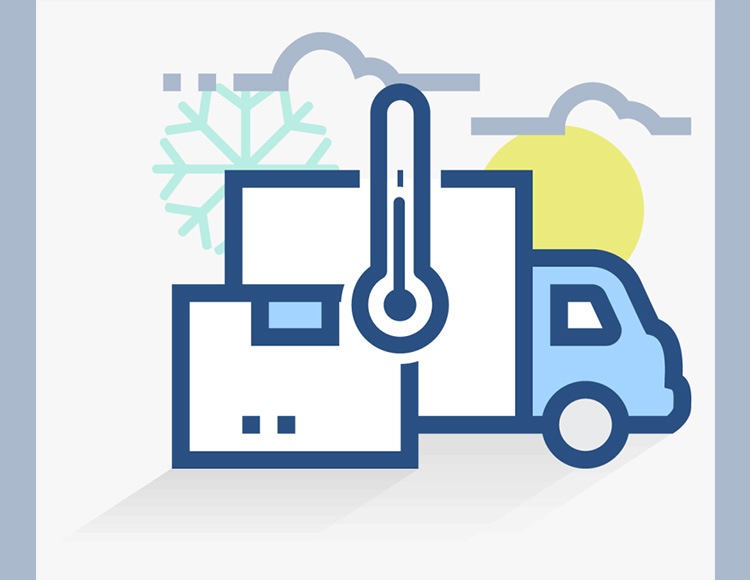
Cold Chain Logistics
Cold Chain Logistics is a temperature-controlled logistics system. To maintain product quality. Enhance security for consumers. As well as reduce product waste, consisting of 2 activities, namely warehouse service and providing transportation services.
When comparing between temperature-controlled warehouse services and temperature-controlled transportation services, we found that in the warehouse business, the average gross profit margin is 15% higher than the transportation business and has a tendency to increase since the rental income has increased by about 5% per year while the main cost is the electricity cost, which tends to increase slightly.
In general, there are 2 types of temperature-controlled warehouse rentals: 3-year long-term lease and temporary one. Between 2013-2017, Long-term rental for 3 years and above has an average gross margin of up to 40 % with an average revenue growth of 27%. Most operators invest in the installation of conveyor equipment, product storage system, and self-employed. Resulting in cost advantage and efficiently manage warehouse space. There are also a few players because it is a business that requires a high initial investment. And has a relatively long payback period, while temporary rentals have average revenue growth of up to 160%, but the average gross margin is relatively low, only 15% because of the need to transfer goods. Resulting in relatively high labor costs.
There are 2 types of temperature-controlled transportation services, which are mainly (> 70%) to business partners and general customer service. In the form of a business partner, the average gross profit margin is at 24% because operators can manage transportation routes efficiently, reducing service costs. While for general customers, the average gross profit margin is 6%.
However, the average gross margin of temperature-controlled transportation services tends to decrease. Since this business does not require very high investment funds. New players can enter this business easily. And most of the products are negotiated every year, resulting in intense price competition. The service price has been cut. In addition, operators must be exposed to the risk of fluctuations in oil prices that account for around 30% -40% of the cost of transportation services.
From the above study, we can assume that the key strategy of the
Cold Chain Logistics business is to create trade alliances with product manufacturers, leading retailers, and franchise restaurants. That will provide entrepreneurs with a stable customer base and the opportunity to receive consistent income. The alliance is often seen in the form of joint ventures and network service development to meet the needs in all dimensions. Another strategy is to make a long-term contract of 3 years or more because entrepreneurs can plan their business operations in order to be worth the investment and able to control operating costs, as well as being able to increase the value of warehouse and transportation utilization.
Cold Chain Logistics has increasingly grown in the categories of meat, vegetables, fruits, seafood, instant food, beverages and dairy products. In 2017, it occupied only 2% of the total logistics market. Increased to 5% in 2018 and tends to continue to grow by about 8% CAGR in the next 3 years (2019-2022), mainly due to the export of fruits to the Chinese market that achieved the leap growth. The recovery of seafood exports from IUU Fishing unlocks, including the rapid expansion of convenience stores and restaurant franchises.
China and Southeast Asian countries consumption of chilled and frozen products, milk, yogurt, ice cream, and other dairy products In large quantities and increasing. Japan has Cold Chain Logistics in almost every corner. And offers rapid freezing and thawing technology.
Japan and ASEAN countries have recently agreed to implement the ASEAN-Japan Cold Chain Logistics Project using Japanese technology.
In general, the average cost of logistics in the food and beverage businesses is around 10% of the sales cost. When the demand for logistics changes to the Cold Chain system that requires expertise and high investment capital. Including building a warehouse, purchasing a freight vehicle, as well as investing in IT to control the cooling system to be stable. As a result, the food and beverage business group turned to use Cold Chain Logistics, which has more expertise to manage. In order to reduce work procedures and reduce logistics costs.
Cold Chain Logistics for food and beverage businesses can be found in 2 forms as followings:
1) Food and beverage businesses with the logistics business joined together in the establishment of Cold Chain Logistics Company to provide services to affiliates, then to general customers
2) Food and beverage businesses use Cold Chain Logistics services from outsource, which provide Cold Chain Logistics services.
Finally, the challenge of this business is Temperature differences used for each product type Requesting permission to transport and correctly store. Environmental and hygiene regulations, such as US RFID temperature history labels, EU Good Distribution Practice regulations. Which all costs more operating expenses. As well as foreign trade measures such as Indonesia restricting imports of horticulture as well as competition from service providers. As there are not many standard Cold Chain Logistics service providers. Therefore it is attractive businesses to create opportunities for business expansion.
Source: J GoodTech Siam Commercial Bank Economic Intelligence Center (EIC)
Counter: 10361
Articles About this
Using AI to Solve Societal Problems
The concept of using artificial intelligence (AI) to address societal issues is entering a new era of development. It's not just about increasing efficiency in tasks but also about opening up significant opportunities for sustainable development in both private and governmental sectors worldwide
Innovation Process: Creating towards Success
The Innovation Process is crucial for the development and growth of an organization, amidst societal and technological changes that drive leaps forward. It enables organizations to lead in the market and gain a competitive edge. This article will explain the innovation process from inception to actual product or service delivery, focusing on step-by-step explanations and deep examples to enhance understanding and provide additional knowledge about the innovation process.
Business Innovation
Innovation is crucial for businesses in today's era, as technological advancements and economic changes require continuous adaptation and development for survival in competitive and challenging markets. This article will analyze business innovation, focusing on creating innovation within organizations, applying it in business contexts, and analyzing metrics for the success of business innovation.


